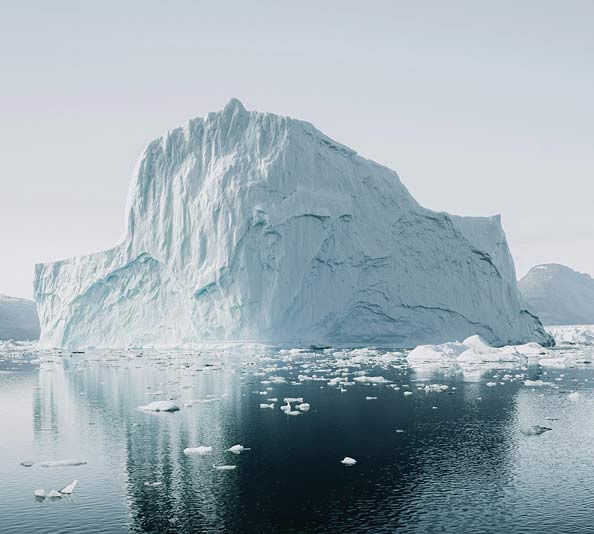In the parable of the blind men and the elephant, the identity of the beast must be determined by touch and conjecture. The first person touches the trunk and says, “This being is like a thick snake.” Another person touches an ear, and it seems like a kind of fan. The leg reminds the toucher of a tree trunk. The side of the elephant feels like a wall, the tail a rope, and the tusk smooth like a spear.
Atmospheric scientists, terrestrial ecologists, and oceanographers went to the Arctic blinkered by their areas of expertise. Like the blind men, the scientists cannot see the whole.
The first group sees the atmosphere warming the ocean’s surface. They measured rising air temperatures and summer sea ice retreat over the Arctic Ocean from mostly covering the ocean to less than a third coverage. Based on their data, they were surprised to see more than the calculated summer sea ice melt. With open water looking darker than sea ice, they said it’s like the temperature difference between a black car seat and a white seat on a sunny day, known as the Albedo effect.
The terrestrial ecologists see sunlight passing through the snowpack to warm the ground below. Insulated by snow, frost touching the earth melts away, leaving a few inches of air space. This subnivean space is occupied by breeding mice, voles, lemmings, and shrews, safe from foxes and owls. These scientists see plants regulating the climate. During the months of 24-hour light, there is a riot of plant growth, drawing down carbon dioxide, taking up water, and photosynthesizing carbohydrates stored in biomass and soil. Plants release bacteria and fungi into the air. Water vapor nucleates around organic particles to form cumulous clouds. When water converts from gas to liquid to solid (snow), atmospheric pressure is lowered. Moist air is drawn from higher-pressure areas over the ocean. More cumulous clouds cool the region.
Oceanographers see the ocean regulating the climate. The motion of the Earth turning to the East sets up a motion in the ocean where currents will always veer right in the Northern Hemisphere. The Gulf Stream veers right off New England to flow to Europe. Sea water temperatures are why palm trees grow on Scotland’s Western Isles and icebergs frequent Newfoundland. Both places have the same latitude and the same amount of sunlight.
Oceanographers once worked from ships underway. They lowered into the ocean a yellow metal torpedo-shaped bathythermograph. Inside was a gold-plated glass slide attached to a bellow that contracted with increasing depth. A thermal coil contracts or expands with changing temperatures. The coil’s end was sharpened to etch the gold on the slide. Pulled from the device, the slide shows a straight vertical line as the temperature stays constant with depth. Suddenly, the line goes horizontal at a specific depth and then vertical. This is the thermocline. It marks the boundary between two water bodies. Water bodies are known for their density as measured by salinity and temperature. The Gulf Stream is a warm 76 to 77 degrees F and has a salinity of 36.5 parts per thousand. The Labrador Current is less than 32 degrees F, and salinity is in the range of 30 to 34 ppm. Being lighter, the Gulf Stream moves easily over the south-bound cold Labrador Current.

When the Arctic Ocean changed from being mostly covered by sea ice to less than a third, in October, more open water froze to become sea ice. The ice is fresh water, and the salt is left behind in the cold water. This frigid, briny concoction is the densest water, and it sinks. More nutrient-rich water flows out of the Arctic into the nutrient-poor Atlantic.
The Gulf Stream barrels north with a volume of 700 Amazon Rivers. It meanders to dissipate energy like a freight train in an accident. In 2011, the Gulf Stream demonstrated more power by wandering onto the continental shelf closer to Rhode Island. In 2007, the Gulf Stream surfaced in Svalbard, causing glaciers on the land to melt. More warm Gulf Stream water flows into the Arctic Ocean to warm the surface water and accelerate the melting of the sea ice.
Like the blind men touching the elephant, when scientists use their logic to explain what their clockwork models portend, they are unable to fathom the natural world’s complexity, the interconnections becoming one, or the agency of life that make our planet inhabitable. Meanwhile, people are free to fortify their beliefs and draw battle lines between them and others.
The blind men can comprehend an elephant only with much dialog, with open minds listening carefully to each other. To better understand and save the Earth, we must listen like blind men and talk with everyone, or you won’t know what part you’re missing.
By Dr. Rob Moir







